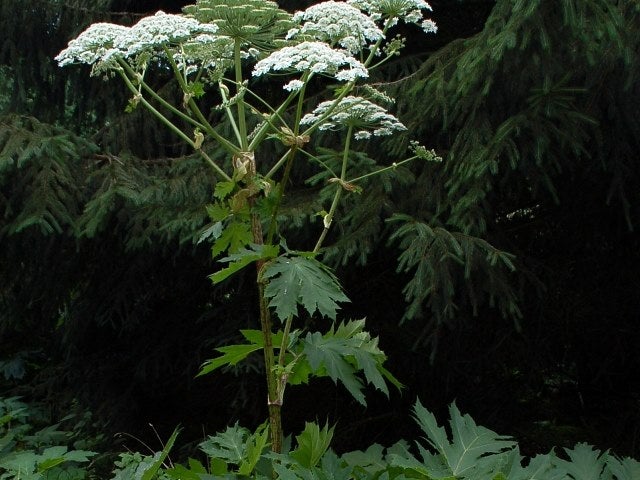Giant Hogweed Continues to Spread
Kevin Felts 06.19.18

Giant hogweed continues to spread across the United States as it was recently found in Virginia for the first time. Giant hogweed, not to be confused with common hogweed, emits a toxic sap when can burn the skin and take months to heal.
Originally from the Caucasus region, (Georgia, Azerbaijan, and Armenia) giant hogweed was brought to England as an ornamental plant. It sounds like whoever transplanted a toxic plant for “ornamental” reasons had a sick sense of humor. Then again, plant some giant hogweed outside a teenage daughter’s window and look for boys with huge blisters.
Anyway, for whatever demented reason, giant hogweed was brought to the United States. As mentioned earlier, when skin comes into contact with giant hogweed sap, the skin can develop 2nd- and 3rd-degree burns which can take months to heal. The way giant hogweed burns the skin is through Phytophotodermatitis, which causes the skin to become hypersensitive to ultraviolet light.
Even though numerous states and the United States federal government have taken steps to prevent the spread of giant hogweed, it continues to be found in new areas.
From Science Alert: Giant Horror Plant That Causes 3rd Degree Burns Has Spread to Yet Another US State.
Listed as a noxious weed in at least eight states, last week the giant hogweed (Heracleum mantegazzianum) was spotted in Virginia for the first time.
According to reports from the Massey Herbarium at Virginia Tech university, about 30 of these towering plants have been found in Clarke County, and locals are warned to keep an eye out for sightings.
Stopping The Spread of Giant Hogweed
Once an invasive species gets established it is almost impossible to stop. For example, look at fire ants. First introduced to the United States in the 1930s, fire ants have spread across the southern part of the United States and have proven impossible to stop.
Rather than just prohibiting the transportation and planting of giant hogweed, maybe affected states should create a corp of workers whose sole job is to scout areas were hogweed has been found, then slay the beast with whatever means necessary.
Instead of being reactive, take a proactive approach. Maybe offer a bounty when someone reports hogweed in a new area.
Opinion
If the United States government can spend trillions of dollars on the military, then why can’t states obtain grants to be proactive about a toxic invasive plant like this?
Much like how conservation programs were introduced by the New Deal, why can’t the federal government put together another conservation program focused on protecting native plant species? During the Great Depression, the Civilian Conservation Corp planted an estimated 3 billion trees. In part, those trees were to replant what the sawmills had clear cut in the early 1900s.
If the Federal Government can assemble the Civilian Conservation Corps and plant billions of trees, why can’t the same thing be done to tackle the giant hogweed problem?